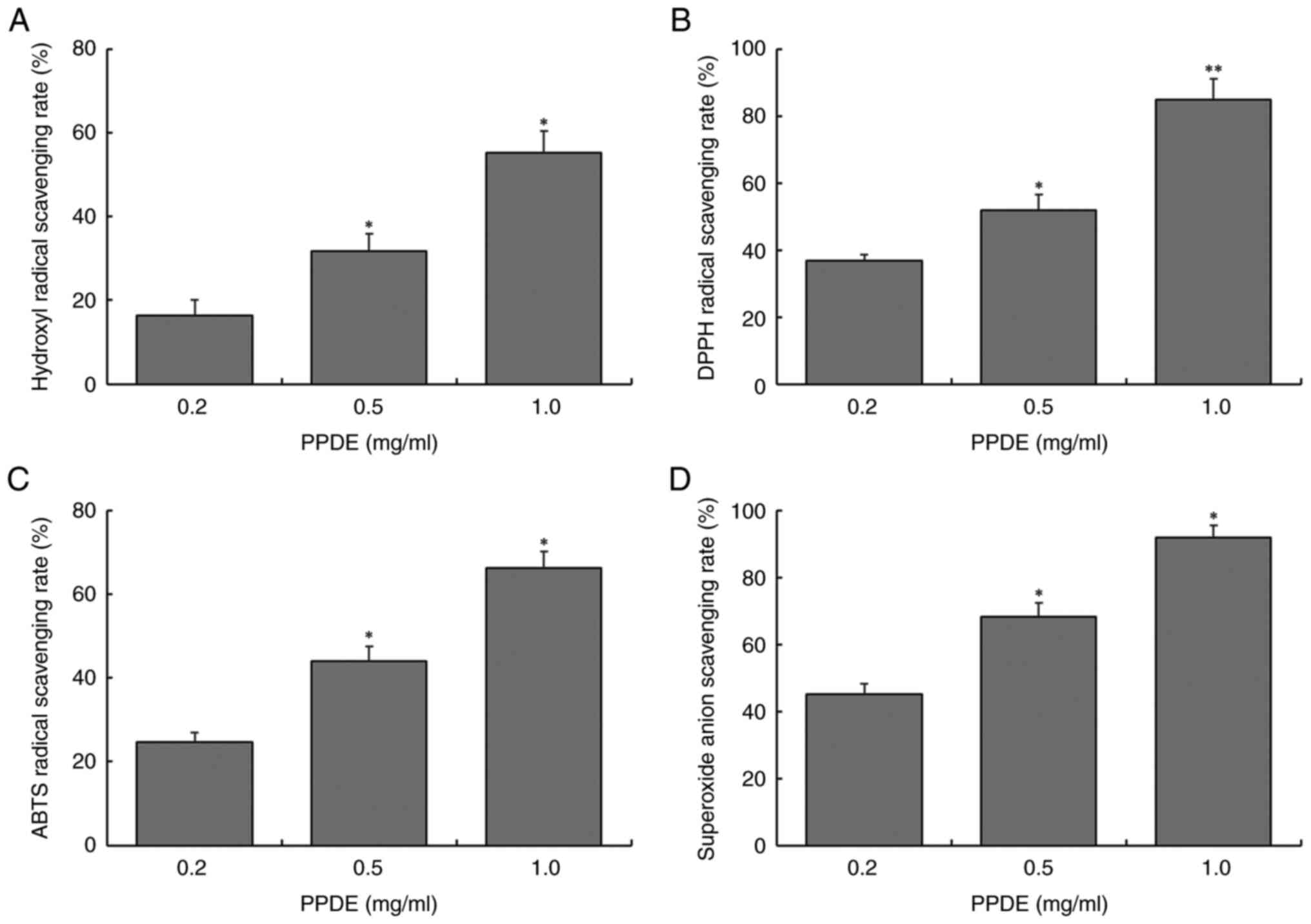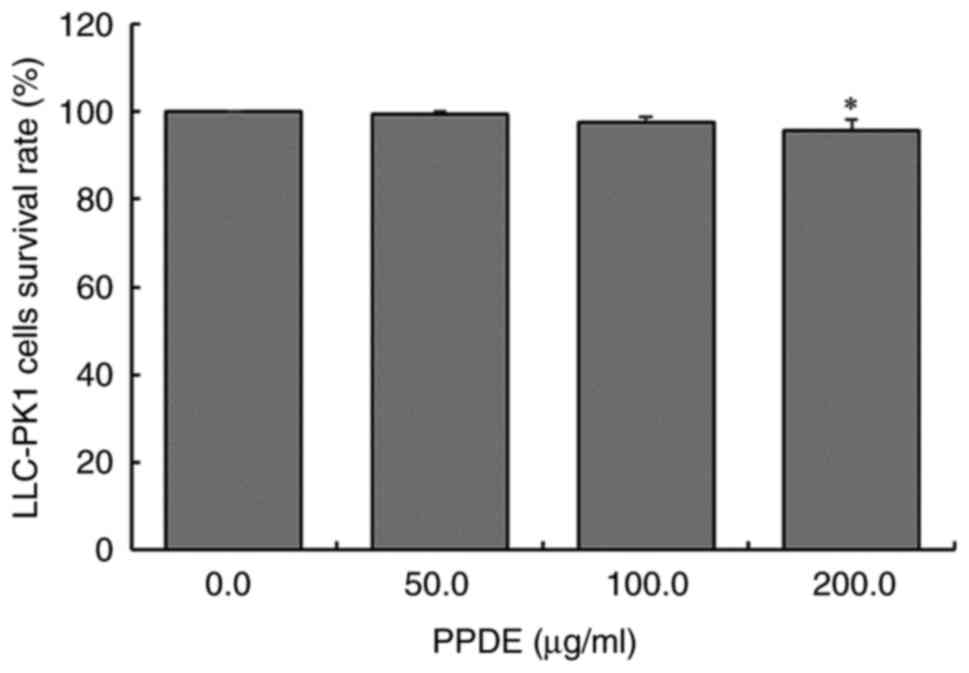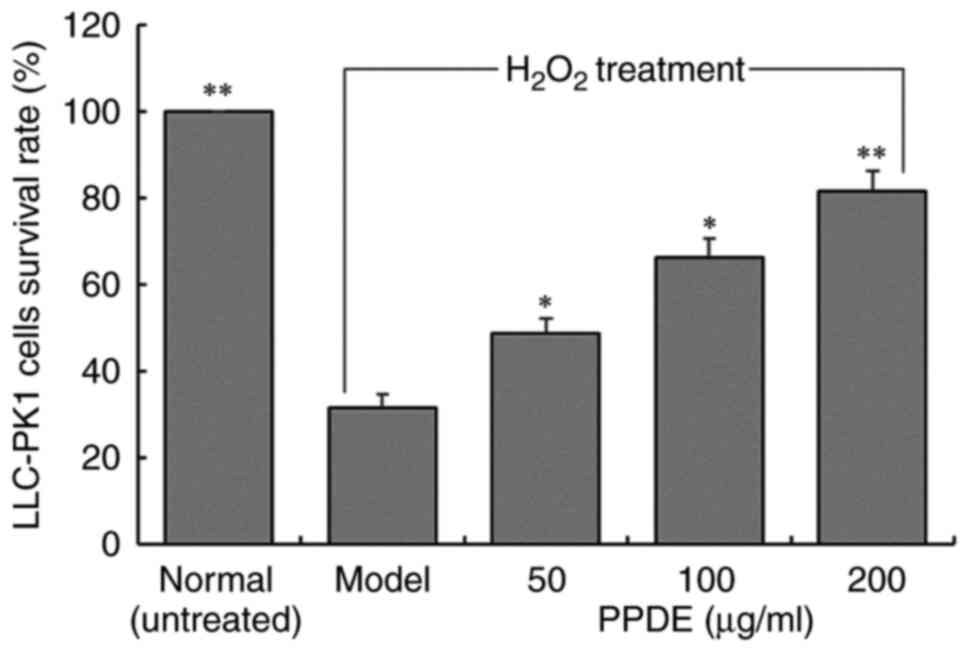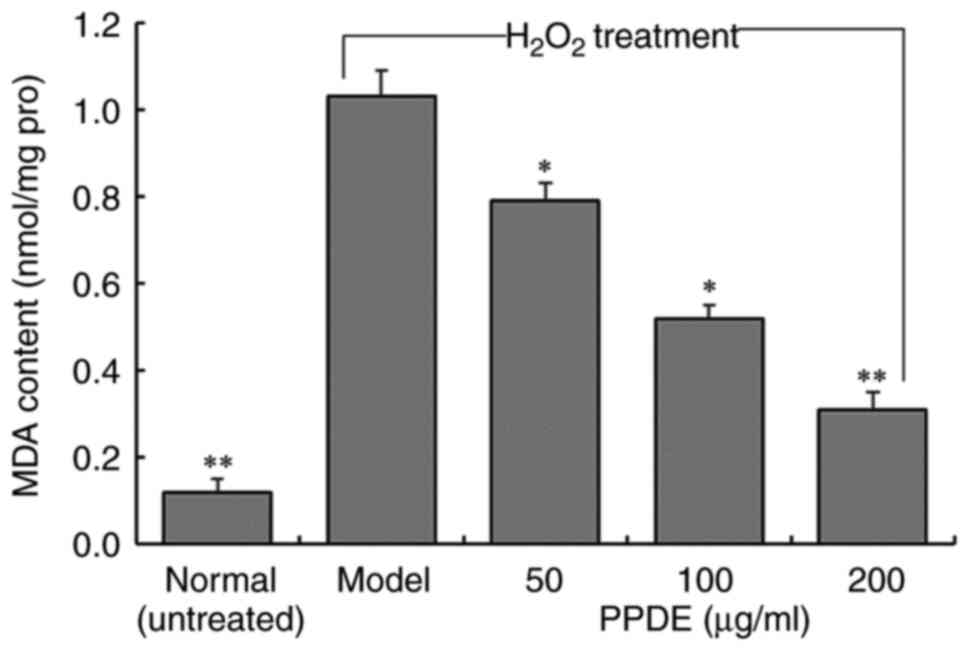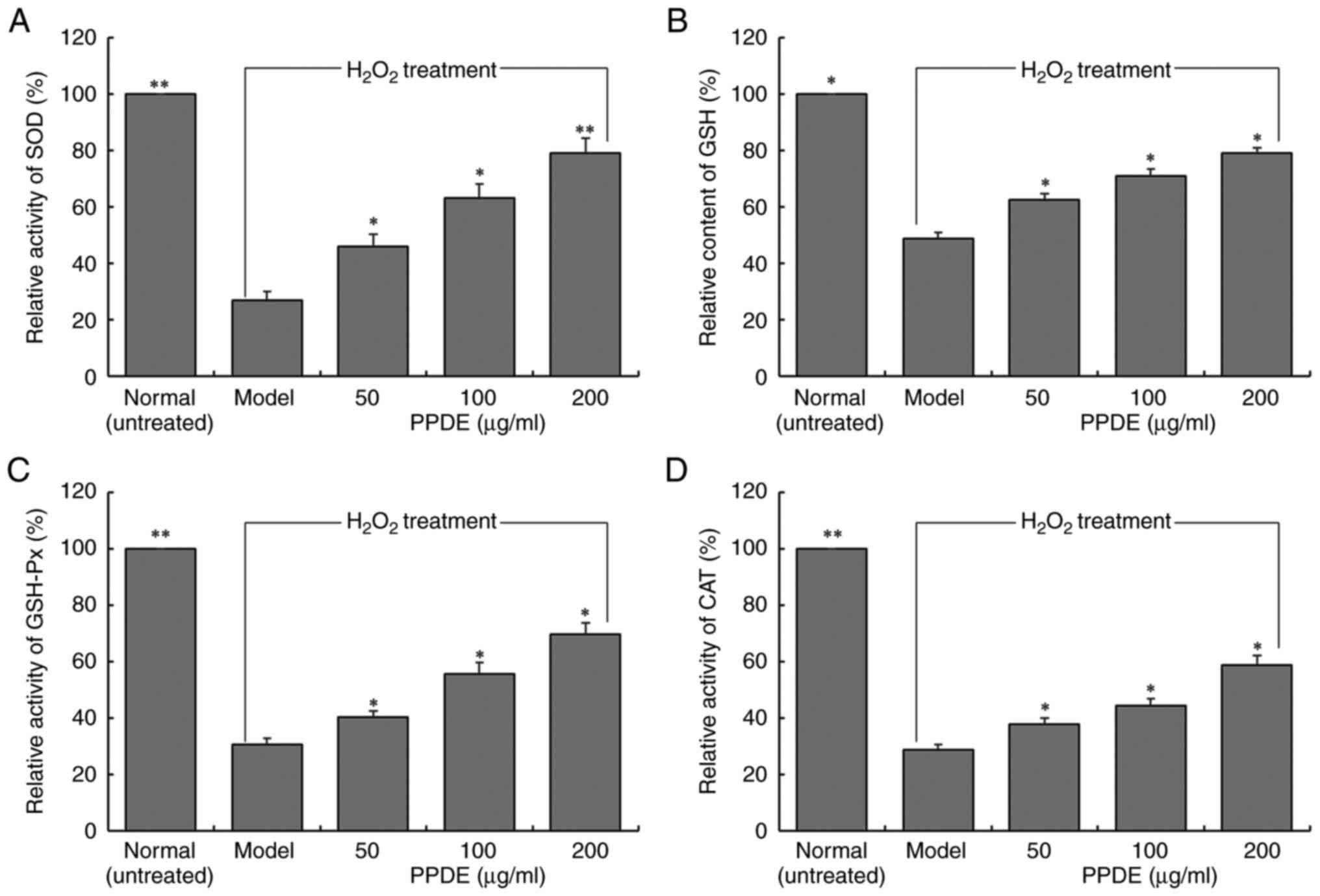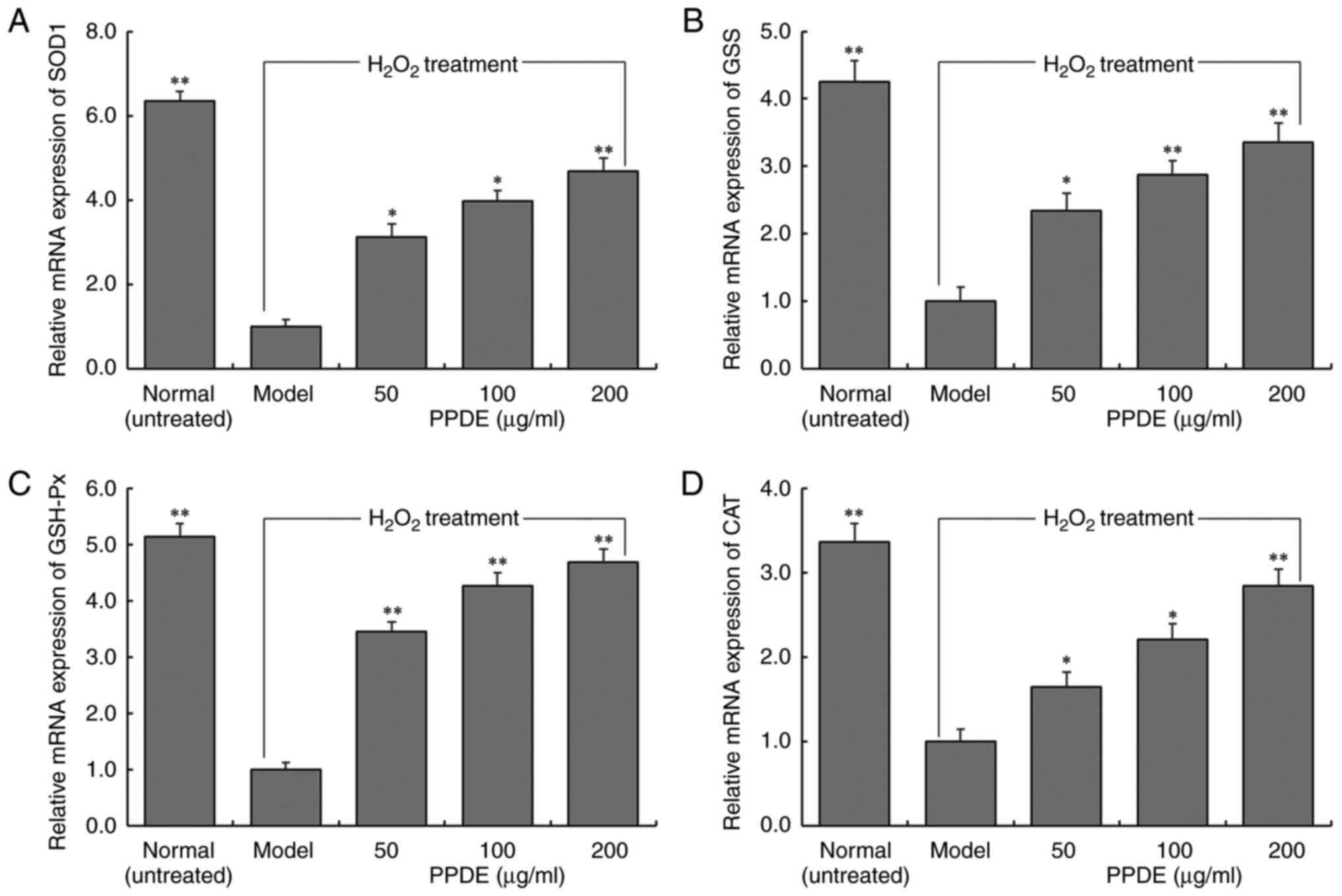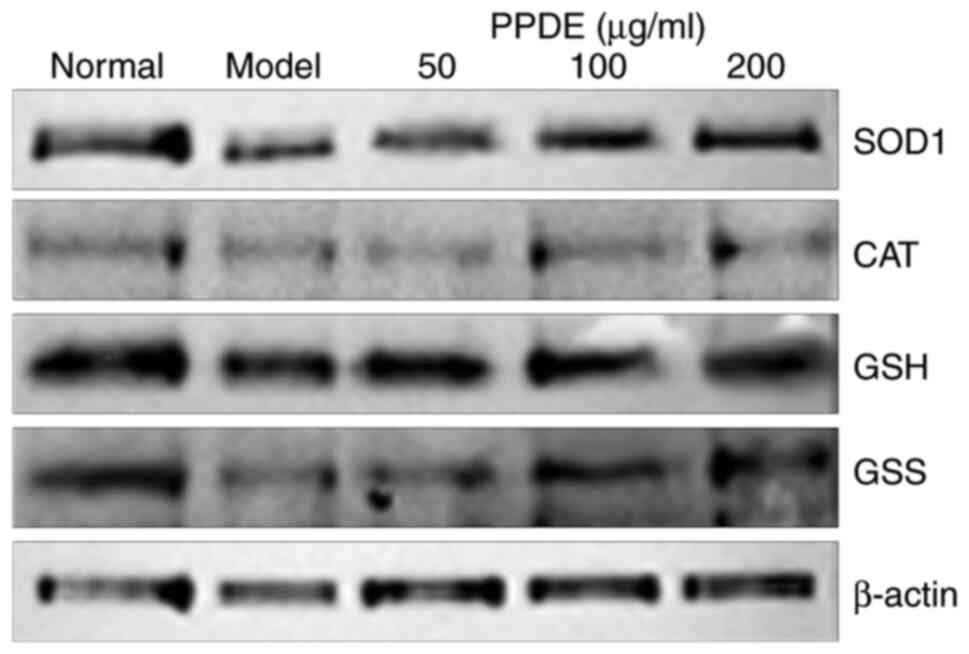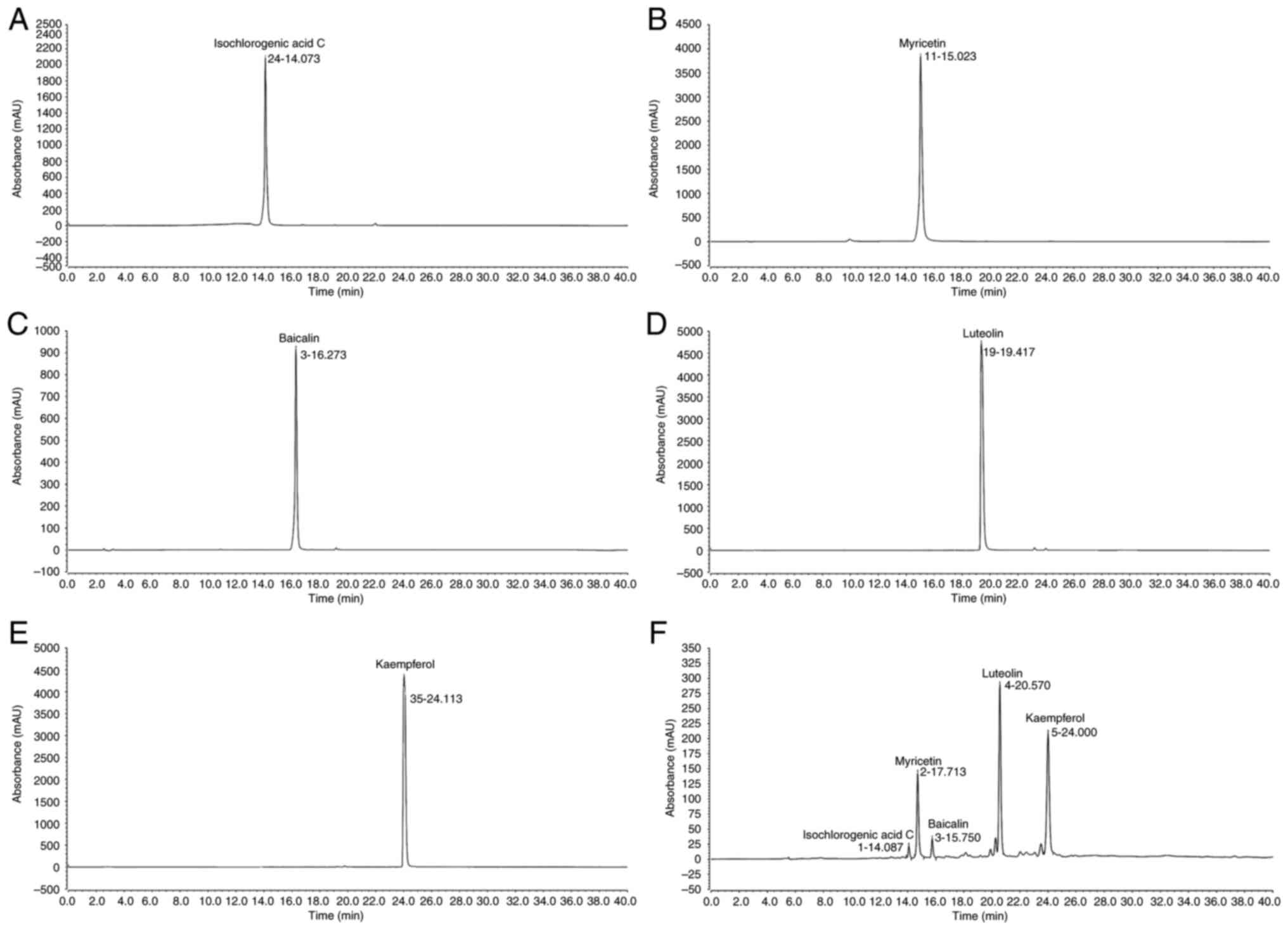|
1
|
Yu PJ, Jin H, Zhang JY, Wang GF, Li JR,
Zhu ZG, Tian YX, Wu SY, Xu W, Zhang JJ and Wu SG: Pyranocoumarins
isolated from Peucedanum praeruptorum Dunn suppress
lipopolysaccharide-induced inflammatory response in murine
macrophages through inhibition of NF-κB and STAT3 activation.
Inflammation. 35:967–977. 2012.PubMed/NCBI View Article : Google Scholar
|
|
2
|
Gao M, Bian C, Zhou W, Liu L, Li B and
Tang L: Dissipation of tiafenacil in five types of citrus orchard
soils using the HPLC-MS coupled with the quick, easy, cheap,
effective, rugged, and safe method. J Separat Sci. 44:1950–1960.
2021.PubMed/NCBI View Article : Google Scholar
|
|
3
|
Xiong YY, Wu FH, Wang JS, Li J and Kong
LY: Attenuation of airway hyperreactivity and T helper cell type 2
responses by coumarins from Peucedanum praeruptorum Dunn in
a murine model of allergic airway inflammation. J Ethnopharmacol.
141:314–321. 2012.PubMed/NCBI View Article : Google Scholar
|
|
4
|
Lee J, Lee YJ, Kim JH and Bang OS:
Pyranocoumarins from root extracts of Peucedanum
praeruptorum Dunn with multidrug resistance reversal and
anti-inflammatory activities. Molecules. 20:20967–20978.
2015.PubMed/NCBI View Article : Google Scholar
|
|
5
|
Bi J, Gao Z, Zhang G and Chen Y: Research
progress on anticancer effects and molecular mechanisms of osthole.
Asian J Tradit Med. 16:53–62. 2021.
|
|
6
|
Liu J, Jia H, Zhu K, Zhao S and Lichtfouse
E: Formation of environmentally persistent free radicals and
reactive oxygen species during the thermal treatment of soils
contaminated by polycyclic aromatic hydrocarbons. Environ Chem
Lett. 18:1329–1336. 2020.
|
|
7
|
Bauer G: Inhibition of membrane-associated
catalase, extracellular ROS/RNS signaling and
aquaporin/H2O2-mediated intracellular
glutathione depletion cooperate during apoptosis induction in the
human gastric carcinoma cell line MKN-45. Antioxidants.
10(1585)2021.PubMed/NCBI View Article : Google Scholar
|
|
8
|
Ibrahim M, Ismail A, Al-Sheraji SH, Azlan
A and Hamid AA: Effects of Mangifera pajang Kostermans juice
on plasma antioxidant status and liver and kidney function in
normocholesterolemic subjects. J Funct Foods. 5:1900–1908.
2013.
|
|
9
|
de Haan A, Eijgelsheim M, Vogt L, van der
Zwaag B, van Eerde AM, Knoers NVAM and de Borst MH: Diagnostic
yield of massively parallel sequencing in patients with chronic
kidney disease of unknown etiology: Rationale and design of a
national prospective cohort study. BMJ Open.
12(e057829)2022.PubMed/NCBI View Article : Google Scholar
|
|
10
|
Zhao X, Wang Q, Li G, Chen F, Qian Y and
Wang R: In vitro antioxidant, anti-mutagenic, anti-cancer and
anti-angiogenic effects of Chinese Bowl tea. J Funct Foods.
7:590–598. 2014.
|
|
11
|
Wang LX, Li CY, Hu C, Gong PS and Zhao SH:
Purification and structural characterization of Dendrobium
officinale polysaccharides and its activities. Chem Biodivers.
18(e2001023)2021.PubMed/NCBI View Article : Google Scholar
|
|
12
|
Takatsuka M, Goto S, Kobayashi K, Otsuka Y
and Shimada Y: Evaluation of pure antioxidative capacity of
antioxidants: ESR spectroscopy of stable radicals by DPPH and ABTS
assays with singular value decomposition. Food Biosci.
48(101714)2022.
|
|
13
|
Xu SJ, Zhu Q, Wang ZH, Xu Y and Zou SJ:
Scavenging activity of superoxide free radical of hesperidin and
hesperetin. Acta Chinese Med Pharmacol. 2015:56–58. 2015.
|
|
14
|
Zhao X, Kim SY and Park KY: Bamboo salt
has in vitro anticancer activity in HCT-116 cells and exerts
anti-metastatic effects in vivo. J Med Food. 16:9–19.
2013.PubMed/NCBI View Article : Google Scholar
|
|
15
|
Zhao X, Yi RK, Feng X and Song JL:
Protective effect of Korean sesame sauce on AAPH-induced oxidative
stress in LLC-PK1 cells. Food Sci. 38:213–218. 2017.
|
|
16
|
Long X, Wu H, Zhou Y, Wan Y, Kan X, Gong J
and Zhao X: Preventive effect of Limosilactobacillus
fermentum SCHY34 on lead acetate-induced neurological damage in
SD rats. Front Nutr. 9(852012)2022.PubMed/NCBI View Article : Google Scholar
|
|
17
|
Hu TT, Chen R, Qian Y, Ye K, Long XY, Park
KY and Zhao X: Antioxidant effect of Lactobacillus fermentum
HFY02-fermented soy milk on D-galactose-induced aging mouse model.
Food Sci Human Wellness. 11:1362–1372. 2022.
|
|
18
|
Pine MD, Greer K and Busbee D: Comparison
of reactive oxygen scavenging systems between a cetacean (DKN1) and
a porcine renal epithelial cell line (LLC-PK1). Comp Biochem
Physiol A Mol Integr Physiol. 147:550–555. 2007.PubMed/NCBI View Article : Google Scholar
|
|
19
|
Xu Y, Liu K, Jin R, Jiang D and Fang D:
Dynamic visualization of free radicals at single oxygen bubbles
using chemiluminescence. Chem Asian J. 16:4049–4052.
2021.PubMed/NCBI View Article : Google Scholar
|
|
20
|
Wang F, Yang Q, Zhao Q and Li X: Cold
shock treatment with oxalic acid could alleviate chilling injury in
green bell pepper by enhancing antioxidant enzyme activity and
regulating proline metabolism. Sci Horticult. 295(110783)2022.
|
|
21
|
Zhang H, Zong R, He H and Huang T: Effects
of hydrogen peroxide on Scenedesmus obliquus: Cell growth,
antioxidant enzyme activity and intracellular protein
fingerprinting. Chemosphere. 287(132185)2022.PubMed/NCBI View Article : Google Scholar
|
|
22
|
Huong DQ, Bay MV and Nam PC: Antioxidant
activity of thiourea derivatives: An experimental and theoretical
study. J Mol Liquids. 340(117149)2021.
|
|
23
|
Liao CY, Yang SF, Wu TJ, Chang H, Huang
CYF, Liu YF, Wang CH, Liou JC, Hsu SL, Lee H, et al: Novel function
of PERP-428 variants impacts lung cancer risk through the
differential regulation of PTEN/MDM2/p53-mediated antioxidant
activity. Free Radic Biol Med. 167:307–320. 2021.PubMed/NCBI View Article : Google Scholar
|
|
24
|
Li C, Chen S, Sha J, Cui J, He J, Fu J and
Shen Y: Extraction and purification of total flavonoids from
Eupatorium lindleyanum DC and evaluation of their
antioxidant and enzyme inhibitory activities. Food Sci Nutr.
9:2349–2363. 2021.PubMed/NCBI View Article : Google Scholar
|
|
25
|
Le G, Yang L, Du H, Hou L, Ge L, Sylia A,
Muhmood A, Chen X, Han B and Huang K: Combination of zinc and
selenium alleviates ochratoxin A-induced fibrosis via blocking
ROS-dependent autophagy in HK-2 cells. J Trace Elem Med Biol.
69(126881)2022.PubMed/NCBI View Article : Google Scholar
|
|
26
|
Ni CX, Gong H, Liu Y, Qi Y, Jiang CL and
Zhang JP: Green tea consumption and the risk of liver cancer: A
meta-analysis. Nutr Cancer. 69:211–220. 2017.PubMed/NCBI View Article : Google Scholar
|
|
27
|
Du W, Zhai P, Liu S, Zhang Y and Lu L: The
copper chaperone CcsA, coupled with superoxide dismutase SodA,
mediates the oxidative stress response in Aspergillus fumigatus.
Appl Environ Microbiol. 87(e0101321)2021.PubMed/NCBI View Article : Google Scholar
|
|
28
|
Ren H, Li J, Liu P, Ren X, Song T, Gao G,
Li D and Liu S: Cloning of catalase gene and antioxidant genes in
Scophthalmus maximus response to metalloprotease of
Vibrio anguillarum stress. J Oceanol Limnol. 40:322–335.
2022.
|
|
29
|
Gao Z, Gao X, Fan W, Liu S, Li M, Miao Y,
Ding C, Tang Z, Yan L, Liu G, et al: Bisphenol A and genistein have
opposite effects on adult chicken ovary by acting on
ERα/Nrf2-Keap1-signaling pathway. Chem-Biol Interact.
347(109616)2021.PubMed/NCBI View Article : Google Scholar
|
|
30
|
Wang HN, Shen Z, Liu Q, Hou XY, Cao Y, Liu
DH, Jiang HJ and Du HZ: Isochlorogenic acid (ICGA): Natural
medicine with potentials in pharmaceutical developments. Chinese J
Nat Med. 18:860–871. 2020.PubMed/NCBI View Article : Google Scholar
|
|
31
|
Phillips PA, Sangwan V, Borja-Cacho D,
Dudeja V, Vickers SM and Saluja AK: Myricetin induces pancreatic
cancer cell death via the induction of apoptosis and inhibition of
the phosphatidylinositol 3-kinase (PI3K) signaling pathway. Cancer
Lett. 308:181–188. 2011.PubMed/NCBI View Article : Google Scholar
|
|
32
|
Gao C, Zhou Y, Li H, Cong X, Jiang Z, Wang
X, Cao R and Tian W: Antitumor effects of baicalin on ovarian
cancer cells through induction of cell apoptosis and inhibition of
cell migration in vitro. Mol Med Rep. 16:8729–8734.
2017.PubMed/NCBI View Article : Google Scholar
|
|
33
|
Wu B, Zhang Q, Shen W and Zhu J:
Anti-proliferative and chemosensitizing effects of luteolin on
human gastric cancer AGS cell line. Mol Cell Biochem. 313:125–132.
2008.PubMed/NCBI View Article : Google Scholar
|
|
34
|
Chen AY and Chen YC: A review of the
dietary flavonoid, kaempferol on human health and cancer
chemoprevention. Food Chem. 138:2099–2107. 2012.PubMed/NCBI View Article : Google Scholar
|















